

“Blackest” Solar Cell Ever Designed Absorbs 99.7 Percent of All Light. The scientists formed the black surface on silicon wafers using a relatively simple liquid bath process.

The porous wafer surface revealed almost no reflectance, which usually decreases the efficiency of solar cells. Near total “blackness” is important for solar cells, because when less light is reflected more sunlight can be converted into electricity. Black silicon solar cells are capable of producing more energy than conventional cells in a range of situations – the cells are more efficient in the morning and afternoon when the sun shines at an angle, and they also outperform cells with current antireflective technology on cloudy days. The difference could be even greater in large-scale solar installations.
The New Jersey-based company was granted an exclusive license recently by the U.S. . + Natcore Technology Photos courtesy Natcore Technology, Wikipedia (Ersol) Solar3D Successfully Fabricates Initial Prototype. Clean Power Published on July 30th, 2012 | by Joshua S Hill Solar3D announced earlier this month the successful fabrication of an initial prototype of its breakthrough 3D solar cell technology, which is designed to maximize conversion of sunlight into electricity.
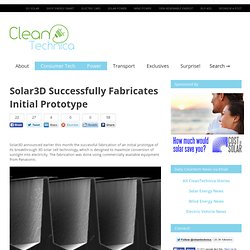
The fabrication was done using commercially available equipment from Panasonic. Image of the end view of the Solar3D prototype captured with a scanning electron microscope “We are pleased to announce the successful fabrication our initial prototype,” said Dr. Sharp Hits Concentrator Solar Cell Efficiency Record, 43.5% Clean Power Published on May 31st, 2012 | by Zachary Shahan.

Ultrathin Lens Could Revolutionise Consumer Technology Form Factor. Lens technology has not advanced much in the past millennia, sticking very close to the original concept designed in the late 1200s.

However, scientists are reporting that they have developed a revolutionary new lens that has the capacity to replace lenses in applications ranging from cell phones to cameras to fibre-optic communication networks. The lens is flat, distortion-free, and so small that more than 1,500 would fit across the width of a human hair! Advanced Solar CPV Manufacturing Plant to Open in NC this Month. Clean Power Published on September 17th, 2012 | by Andrew Semprius is readying the opening of its first manufacturing facility later this month in Henderson, North Carolina.

With backing and support from the Obama Administration, the DOE, and the National Renewable Energy Laboratory (NREL) in Golden, Colorado, Semprius uses some of the world’s most efficient solar PV cells. Rawlemon’s Spherical Solar Energy-Generating Globes Can Even Harvest Energy from Moonlight. The solar energy designers at Rawlemon have created a spherical, sun-tracking glass globe that is able to concentrate sunlight (and moonlight) up to 10,000 times.
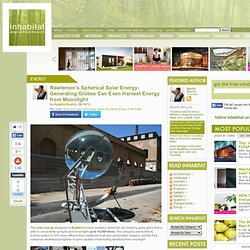
The company claims that its ß.torics system is 35% more efficient than traditional dual-axis photovoltaic designs, and the fully rotational, weatherproof sphere is even capable of harvesting electricity from moonlight. The ß.torics system was invented by Barcelona-based German Architect André Broessel. He sought to create a solar system that could be embedded in the walls of buildings so that they may act as both windows and energy generators. MIT Develops 'Inverted Nanopyramid' Solar Surface That Cuts Silicon Use by 90% in Photovoltaic Cells. A team of researchers at MIT has developed a new type of textured solar surface that could bring down the cost of photovoltaic technology by reducing the thickness of silicon used by more than 90% while still maintaining high efficiency.
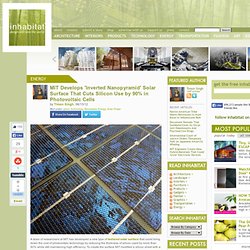
To create the surface MIT modified a silicon sheet with a pattern of tiny inverted pyramids. These indentations, each less than a millionth of a meter across, are able to trap light rays just as effectively as solid silicon surfaces – which are 30 times thicker. The study is documented in the journal Nano Letters in a paper by MIT postdoc Anastassios Mavrokefalos, professor Gang Chen, and three other postdocs and graduate students, all from MIT’s Department of Mechanical Engineering. Speaking about the team’s breakthrough, Anastassios Mavrokefalos said: ”We see our method as enhancing the performance of thin-film solar cells. It would enhance the efficiency, no matter what the thickness.” V3Solar's Spinning Cone-Shaped Solar Cells Generate 20 Times More Electricity Than Flat Photovoltaics.
If there's one constant among the vast majority of solar panel designs, it's flatness; while solar panels can be equipped to tilt to follow the sun's path through the course of the day, there are still significant efficiency limitations to this basic design.
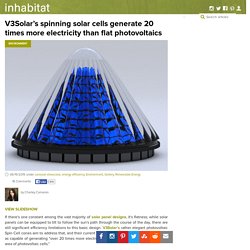
V3Solar's rather elegant photovoltaic Spin Cell cones aim to address that, and their current prototype was recently third-party verified as capable of generating "over 20 times more electricity than a static flat panel with the same area of photovoltaic cells. " The V3 Spin Cell was developed through collaboration with industrial design team Nectar Design. The company believes that the Spin Cell could be a game-changer in its market. On their website V3 explains that if one places a 20x solar concentration on a flat, static solar panel then “the temperature quickly reaches 260 degrees F, the solder melts within ten seconds, and the PV fails. With the same concentration on the Spin Cell, the temperature never exceeds 95 degrees F.”
UCLA Develops Electricity-Generating, Transparent Solar Cell Windows. A team from UCLA has developed a new transparent solar cell that has the ability to generate electricity while still allowing people to see outside. In short, they’ve created a solar power-generating window! Described as “a new kind of polymer solar cell (PSC)” that produces energy by absorbing mainly infrared light instead of traditional visible light, the photoactive plastic cell is nearly 70% transparent to the human eye—so you can look through it like a traditional window.
In 2010, we reported that UK-based Oxford Photovoltaics had won a £100,000 ($150,000) prize to develop the technology for screen-printed organic solar cells that could be placed onto window panes in order to generate energy. However today, it seems like a team from UCLA has gone one step further and developed a new transparent solar cell that has the ability to generate electricity while still allowing people to see outside. Windows that could power our homes? Via PlanetSave Lead image: bgottsab. Liquid Solar Cells that Can be Painted onto Surfaces. Clean Power Published on April 30th, 2012 | by Zachary Shahan New research out of the University of Southern California (USC) advances the development of “cheap, stable solar cells made from nanocrystals so small they can exist as a liquid ink and be painted or printed onto clear surfaces.”
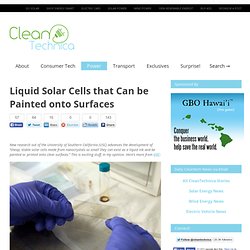
This is exciting stuff, in my opinion. One Per Cent: Green Machine: Transparent solar cells could come cheap. Hal Hodson, technology reporter (Image: UCLA) Windows and smartphone screens may soon come with built in solar power, letting through visible light while gathering energy from other parts of the spectrum.
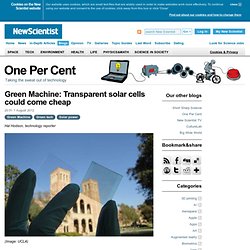
Sharp Unveils See-Through Transparent Solar Panels Perfect For Balconies And Windows! Rooftop solar installations are great for homeowners, or those with eco-conscious landlords – but what about the rest of us? Sharp recently announced a break-through in home solar technology that could begin to answer that question. The company unveiled a transparent solar panel that can be mounted on balcony railings or high-rise windows without obstructing the view. The innovative new panels (which will launch in Japan on October 1) are tinted black, but they’re semi-transparent. This allows them to be arranged and installed on surfaces other than the rooftop. According to a recent press release, each panel is made of laminated glass infused with photovoltaic cells, and they will deliver a solar power conversion efficiency of about 6.8-percent with a maximum output of 95 watts.
The panel stands at 4.5-feet wide by 3.2-feet tall and is only 0.37 inches thick. . + Sharp Via CNET. One Step Closer To Invisible Solar Cells In Our Windows. “That’s not a window – that’s a solar panel.” At least, that’s what one might be able to say at some point, according to New Energy Technologies, Inc. The company is known for its development of see-through solar cells (which we’ve talked about before ), and this week it’s just a little closer to making its almost invisible solar cells a production reality. The new breakthrough involves the manufacturing technique the company uses. Working with the US Department of Energy’s National Renewable Energy Laboratory, New Energy thinks it has figured out how to get material cost down and has also designed a new application technique.
Said technique is supposed to raise the conversion efficiency of the finished product. Power-Generating Windows Offer New Horizons for Office Energy Efficiency. Clean Power Published on July 6th, 2012 | by Glenn Meyers For solar enthusiasts on limited budgets, rooftop panels are no longer the only way to produce clean electricity. Try all of the south-facing windows, instead. Solar Power From the Windows - the See-Through Solar Cell From Sharp. Clean Power Published on September 26th, 2012 | by Charis Michelsen There is a list of reasons why windows are awesome things to have in any room, and Sharp just added to that list: the company has announced the release of see-through solar cell modules designed to act as architectural glass.
Starting October 1st, customers in Japan will be able to buy power-generating windows from Sharp. The idea is to combine solar power generation (always a great thing to have) with lots of natural light (another great thing to have). The new solar cell module does it, and does it fairly well. NREL Helps Make Solar Panels Last.
Next-Gen Solar Cells Receive Efficiency Boost from Graphene. Kyocera Solar Modules Tested to Show Only 8.3% Performance Degradation After 20 Years. Clean Power Published on September 27th, 2012 | by Nicholas Brown 945-watt solar panels from Kyocera that were first installed in 1992 by Hespul were recently tested by Atomic Energy and Alternative Energies Commission (which is connected to the State Solar Research Institute INES — and the certification laboratory CERTISOLIS) to determine how much their performance had degraded. New Inexpensive and More Environmentally Friendly Solar Cell.
Students Create Award-Winning Robot That Cleans Solar Panels. Solar panels must be regularly cleaned and maintained in order to keep them operating efficiently and maximize the amount of sunlight they convert into electricity. New Method Makes Solar-Cell Production Cheaper, Easier. The Korean company Hanwha SolarOne has shown the first commercial-sized solar panel to use a novel technology for producing silicon wafers, which are the most expensive part of a solar cell. Developed by the Santa Clara, California-based startup Crystal Solar, the technology makes wafers that are less than a third the thickness of conventional wafers.
It wastes less silicon during processing than conventional approaches and greatly reduces the amount of equipment needed to make the wafers, potentially cutting wafer costs in half. University of Arizona's Breakthrough Telescope Solar Panel Doubles Efficiency. IBM Sets New World Record For Photovoltaic Cell Efficiency. New Efficiency Record for Photovoltaic Cells Set, Jump in Efficiency Thanks to Heterojunction Technology. Clean Power Published on September 30th, 2012 | by James Ayre. Silevo's Triex Hybrid Solar Cell Has Reached 21% Conversion Efficiency at Production. IBM Researchers Have Developed Record-Breaking PV Cells. New Record Efficiency for Next-Gen Solar Cells. German Scientists Double the Efficiency of Black Silicon Solar Cells. Will Robot Trackers Reduce the Costs of Solar? Le graphène ? En bonne voie pour une production industrielle. New low cost method for making graphene.
New Graphene Solar Cell Efficiency Record. Meet Silicene, Single-Atom-Thick Sheets of Silicon That Could Supersede Graphene. All-carbon solar cell harnesses infrared light. Olympicene: New Molecule Shaped Like the Olympic Rings Could Revolutionize Solar Technology. Decorated Nanowires Could Lead To More Efficient Batteries and Solar Cells. Carbon Nanotubes Improve, Cut Cost of Dye-Sensitized Solar Cells. Piece by piece. DIY Solar Pocket Factory Machine Can Print a Solar Panel Every 15 Seconds! Inner Workings of Solar Cell: New Insight into How Solvent Mixtures Affect the Structure of Organic Solar Cells. Researchers Find Clues to Efficient Organic Photovoltaic Material (Could Help Create New Materials to Improve Solar Cells) Solar Cell Made of a Single Molecule: Electrical Current Generated from Individual Protein Complex. Researchers explain how dye-based nanotubes can help harvest light’s energy. "Artificial Leaf" Hits Development Hurdle. Princeton, Navy and Air Force Team on Biomimicry Solar Cell Research.
Bio antenne amplificatrice. New technique allows simulation of noncrystalline materials.